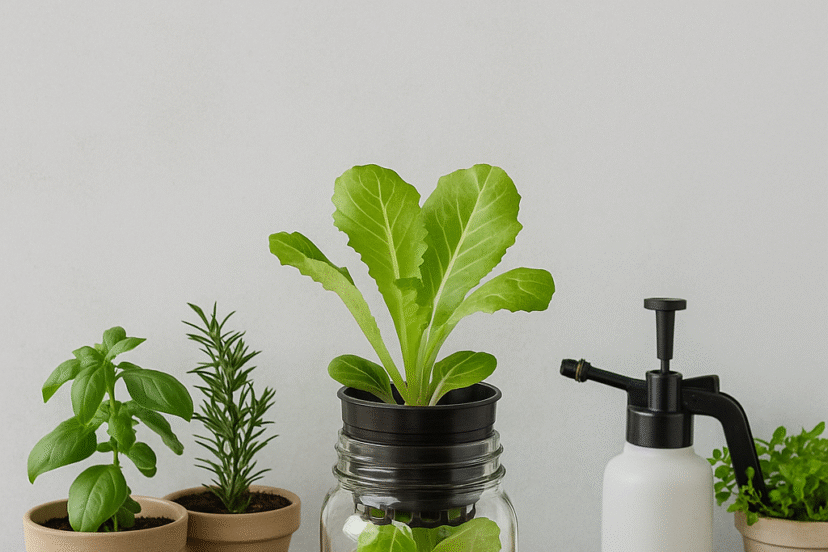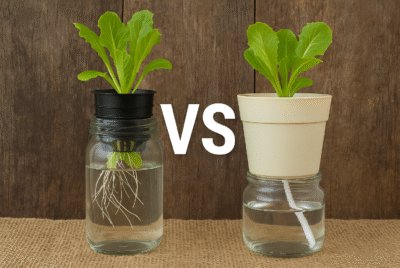Top 3 Beginner-Friendly Hydroponic Systems: Grow Smarter Without Soil
If you’re new to gardening—or frustrated with traditional soil setups—hydroponics might be the fresh start you didn’t know you needed. Hydroponic gardening is soil-free, mess-free, and incredibly rewarding. For beginners, it offers fast growth, fewer pests, and the ability to grow food year-round, even in small spaces.
But here’s the catch: many first-timers get overwhelmed by all the gear, jargon, and pumps. That’s why we’re breaking down the Top 3 Beginner Hydroponic Systems that are simple, affordable, and actually work—without needing a degree in plant science.
💧 System #1: Kratky Method – The No-Pump Passive Powerhouse
✅ Best For: Absolute beginners, busy schedules, small leafy greens
Imagine growing lettuce or basil in a jar—with no electricity, no pumps, and no moving parts. That’s the Kratky Method. It’s one of the most beginner-friendly hydroponic techniques because it requires almost no maintenance once set up.
How It Works:
Plants are suspended above a reservoir filled with nutrient solution. As they grow, the water level drops, exposing the roots to air and creating a natural oxygen exchange—no air pump needed.
Why You’ll Love It:
- No moving parts = nothing to break
- Silent & compact – ideal for apartments or indoor growing
- Perfect for fast-growing greens like lettuce, basil, spinach
Common Mistakes to Avoid:
- Letting the water level drop too low too quickly
- Using tap water with too much chlorine
- Overcrowding jars with multiple plants
🔧 What You Need:
- Mason jar or plastic container
- Net pot and hydroton (clay pebbles)
- Nutrient solution
- Seeds + starter cube (like rockwool)
🛒 Recommended Kratky Kit:
👉 Kratky Wide-Mouth Jar Kit – 4 Pack
💨 System #2: Deep Water Culture (DWC) – Oxygen-Rich and Reliable
✅ Best For: Fast growers, leafy greens, anyone who wants more yield
DWC takes the Kratky method up a notch by actively oxygenating the water using an air pump and air stone. This keeps your plant roots submerged in nutrient-rich water while constantly providing the oxygen they need to avoid root rot.
How It Works:
Roots hang directly into a deep container of nutrient solution. An aquarium pump delivers oxygen to the roots 24/7 via bubbling water, boosting plant health and speed.
Why You’ll Love It:
- Faster, larger plant growth
- Great for basil, lettuce, kale, and even cherry tomatoes
- Reliable performance with basic gear
Watch Out For:
- Root rot if air pump fails
- pH balance must be monitored weekly
- Slight hum from air pump (some systems are quieter than others)
🔧 What You Need:
- 5-gallon bucket or tub
- Net pot and hydroton
- Air pump + air stone
- Nutrient solution
- Seeds and starter plugs
🛒 Recommended DWC Kit:
👉 VIVOSUN 5-Gallon DWC Bucket Kit
🌡 System #3: Wick System – The Simplest Automated Solution
✅ Best For: Ultra-low-maintenance, herbs and microgreens, busy schedules
The wick system is like the chill cousin of hydroponics. It uses capillary action to slowly draw nutrient water up to the plant roots via absorbent wicks—no pumps, timers, or fuss.
How It Works:
A reservoir holds nutrient solution below a grow tray. Wicks (often made of cotton rope or felt) pull water up into the grow medium, keeping it moist without overwatering.
Why You’ll Love It:
- No electricity required
- Easy to build from recycled containers
- Great for herbs like mint, chives, or thyme
Common Issues:
- Not suitable for water-hungry plants (like tomatoes)
- Wicks may clog over time—clean monthly
🔧 What You Need:
- 2 containers (one for the plant tray, one for the reservoir)
- Cotton wicks or felt strips
- Grow medium (like perlite or coco coir)
- Nutrient mix
🛒 Recommended Wick Kit:
👉 Indoor Wick System Herb Garden Starter
📊 Side-by-Side Comparison: Which System is Right for You?
| Feature | Kratky Method | Deep Water Culture (DWC) | Wick System |
|---|---|---|---|
| Electricity Needed | ❌ No | ✅ Yes | ❌ No |
| Maintenance Level | 🔹 Very Low | 🔸 Moderate | 🔹 Very Low |
| Setup Cost | 💲 | 💲💲 | 💲 |
| Best For | Lettuce, basil | Kale, tomatoes | Herbs, microgreens |
| Ideal Environment | Windowsill | Balcony, tent | Kitchen shelf |
| Grow Speed | Medium | Fastest | Slower |
| System Lifespan | Refill per season | Ongoing with maintenance | Reusable |
🌱 Tips for First-Time Hydroponic Gardeners
- Start small – One plant is all you need to learn.
- Check water weekly – pH and nutrient levels are key.
- Light matters – Add grow lights if sunlight is limited.
- Use clean water – Let tap water sit 24 hrs to remove chlorine.
- Label your jars – Know what you planted and when.
🧪 Product Recommendations Recap
Kratky Picks:
DWC Picks:
Wick Picks:
🚀 Conclusion: Pick Your System and Start Growing Today
You don’t need to be a master gardener—or even own a backyard—to start growing food at home. With just a jar, a bucket, or a basic wick system, you can start harvesting fresh, clean produce in a matter of weeks.
Whether you’re looking for a no-tool beginner setup like Kratky, a power-packed DWC system, or a laid-back wick setup for herbs, there’s a system for your space and lifestyle.
👉 Read the Beginner’s Starter Kits System Guide →
👉 Download your free Hydroponics Starter Kit Handbook →
Your garden doesn’t need soil. It just needs you—and a little water, light, and love.
Affiliate Disclosure: Some links in this post may be affiliate links. If you make a purchase through them, we may earn a small commission—at no extra cost to you. We only recommend products we personally use and trust.
*We may earn a commission from purchases made through our links, at no cost to you. This does not affect our product recommendations. Please see our disclosure to learn more.




